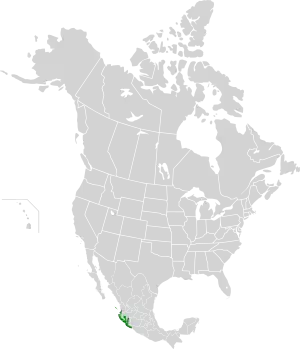Jalisco dry forests
The Jalisco dry forests is a tropical dry broadleaf forest ecoregion in southwestern Mexico.
| Jalisco dry forests | |
|---|---|
 Ecoregtion territory (in green) | |
| Ecology | |
| Realm | Neotropical |
| Biome | tropical and subtropical dry broadleaf forests |
| Borders | |
| Geography | |
| Area | 25,445 km2 (9,824 sq mi) |
| Country | Mexico |
| States | Colima, Jalisco, Michoacán, and Nayarit |
| Conservation | |
| Conservation status | Critical/endangered |
| Global 200 | Mexican dry forests |
| Protected | 1,713 km² (7%)[1] |
Geography
The Jalisco dry forests occupy the coastal lowlands and foothills of Jalisco, Colima, Nayarit, and Michoacan states. The Pacific Ocean lies to the west and south, and the ecoregion includes the Islas Marías The higher-elevation pine-oak forests of the Sierra Madre del Sur and Trans-Mexican volcanic belt lie inland. The Sinaloan dry forests lie to the north, and the Southern Pacific dry forests lie to the southeast across the Balsas River.
Cities in the ecoregion include Puerto Vallarta, Manzanillo, and Colima.
Climate
The climate is tropical and subhumid. Rainfall averages 730-1200 mm per year, falling mostly during the June through October rainy season.[2]
Flora
The principal vegetation in the ecoregion is tropical dry forest. Many trees lose their leaves during the winter dry season. The mature forests have a multi-layered structure, with a middle layer of trees from 15-20 meters high, and an upper layer 20-30 meters high. The layers are characterized by different species, with Astronium graveolens, Bernoullia flammea, Sideroxylon cartilagineum, Bursera arborea, Calophyllum brasiliense, Dendropanax arboreus, Ficus cotinifolia, and Swietenia humilis in the middle layer, and Cordia alliodora, Croton pseudoniveus, Lonchocarpus lanceolatus, Trichilia trifolia, and Caesalpinia eriostachys in the upper layer. Columnar and arborescent cacti are common, including Opuntia excelsa and species of Pachycereus, Stenocereus, and Cephalocereus. Creepers are common in the understory, and there are few epiphytes. Palm forests of Attalea guacuyule occur along the coast.[2]
The forests are among the most diverse in the Neotropics, with about 1200 species of plants, of which 16% are endemic.[2]
Fauna
Of the ecoregion's 724 species of vertebrates, 233, or 29%, are endemic.[2]
20% of the mammal species are endemic to the ecoregion, and 27% are endangered. Endemic species include Mexican shrew (Megasorex gigas), trumpet-nosed bat (Musonycteris harrisoni), Michoacan deer mouse (Osgoodomys banderanus), Chamela rat (Hodomys alleni), and Magdalena rat (Xenomys nelsoni).[2]
The ecoregion in home to 300 bird species. There are several endemic species, including the Mexican parrotlet (Forpus cyanopygius), rufous-bellied chachalaca (Ortalis wagleri), and San Blas jay (Cyanocorax sanblasianus). 55% of the bird species are year-round residents, and 45% are winter migrants from the Nearctic.[2]
51% of reptile species and 58% of amphibians are endemic.
Protected areas
A 2017 assessment found that 1,713 km², or 7%, of the ecoregion is in protected areas. Approximately 29% of the unprotected area is still forested.[1] Protected areas include Chamela-Cuixmala Biosphere Reserve and Islas Marías Biosphere Reserve.
See also
External links
- "Jalisco dry forests". Terrestrial Ecoregions. World Wildlife Fund.
References
- Eric Dinerstein, David Olson, et al. (2017). An Ecoregion-Based Approach to Protecting Half the Terrestrial Realm, BioScience, Volume 67, Issue 6, June 2017, Pages 534–545; Supplemental material 2 table S1b.
- "Jalisco dry forests". Terrestrial Ecoregions. World Wildlife Fund.